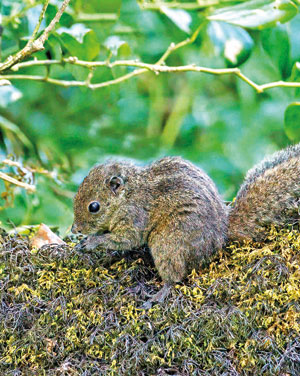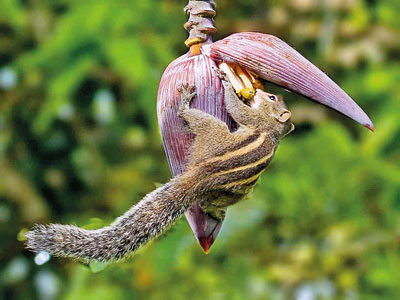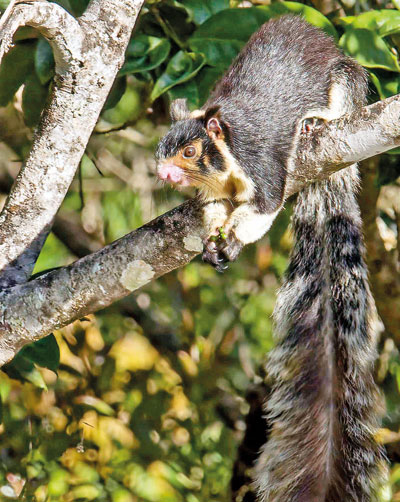News
Pets or pests: Our arboreal acrobats have their day
View(s):By Malaka Rodrigo
With their cuddly, baby-like faces, energetic dashes through tree branches, and sharp calls, palm squirrels are among the friendliest members of urban wildlife, often seen in home gardens. These charming creatures, however, have lesser-known relatives that inhabit forested or densely wooded areas.
To celebrate and appreciate these fascinating animals, Squirrel Appreciation Day is observed annually on January 21.
Originally established in 2001 and primarily celebrated in the Western world, particularly by American nature enthusiasts, Squirrel Appreciation Day has also become an opportunity for Sri Lankan nature lovers to explore the diverse members of the squirrel family, says Sampath De Alwis Goonatilake of the International Union for Conservation of Nature (IUCN).

Dusky - striped squirrel ( endemic )
Squirrels belong to the family Sciuridae, named after the Greek word meaning “shadow-tailed,” in reference to their long, bushy tails. Sri Lanka is home to six species of squirrels in this family, categorized as striped squirrels, giant squirrels, and flying squirrels.
The most common striped squirrel is the three-striped palm squirrel (Funambulus palmarum), identified by its three white or pale stripes running along its back, with the central stripe extending from the neck to the tail. Known locally as ‘lena’ in Sinhala and ‘anil’ in Tamil, this species has four subspecies in Sri Lanka, each with minor variations in appearance.
Two other striped squirrels are largely confined to forested areas: the Dusky-striped Squirrel (Funambulus obscurus) and the Flame-striped Jungle Squirrel (Funambulus layardi). Both species are endemic to Sri Lanka and categorized as “Vulnerable” due to their restricted habitats and reliance on forest cover.
Sri Lanka also hosts two species of flying squirrels, which are remarkable for their ability to glide between trees. These nocturnal creatures use a thin membrane of skin, stretching from their wrists to their ankles, as a glider wing, with their bushy tails acting as rudders for steering and stabilization during flight.
Known locally as ‘hambawa’ in Sinhala and ‘parrakkum-anil’ in Tamil, the two species are the Giant Grey Flying Squirrel (Petaurista philippensis) and the Small Flying Squirrel (Petinomys fuscocapillus).
According to Goonatilake, studying the wild squirrels in the wild is difficult due to their shy nature, unlike the palm squirrel, which tolerates close human presence. However, habitat loss and fragmentation are significant threats to wild squirrels’ survival.

Palm squirrel
The Giant Squirrel (Ratufa macroura) has garnered particular attention for its destructive feeding habits, especially in coconut plantations nowadays. This species, the largest member of the squirrel family in Sri Lanka, measures about 35 cm in body length, with a tail of similar size. Sri Lanka hosts three subspecies of the giant squirrel, which are distinguishable by colouration, with darker individuals found in the wet zone.
While the giant squirrel is often labelled a pest, its behavior is partly a consequence of deforestation, says Prof. Sampath Seneviratne of the University of Colombo. Historically, these squirrels relied on fruiting trees in forests, but the clearing of these areas has driven them to farmland in search of food.

Giant squirrel. Pix by Sarath De Vass Gunawardane
Aerial predators such as the Black Eagle once controlled squirrel populations. However, habitat destruction has diminished the presence of these predators, contributing to an increase in giant squirrel numbers, says Prof.Seneviratne. Black Eagles, which prey on giant squirrels during their breeding season, are now less common, further enabling the expansion of giant squirrel populations, Prof. Seneviratne who is also an ornithologist explains.
Squirrels, from the familiar palm squirrel in our gardens to the elusive flying squirrels of the forests, are integral to Sri Lanka’s rich biodiversity. Squirrel Appreciation Day offers an opportunity to reflect on the importance of these creatures, understand the challenges they face, and promote their conservation in an ever-changing landscape.

The best way to say that you found the home of your dreams is by finding it on Hitad.lk. We have listings for apartments for sale or rent in Sri Lanka, no matter what locale you're looking for! Whether you live in Colombo, Galle, Kandy, Matara, Jaffna and more - we've got them all!

